06/20/2021 – The original Colt 1911 National Match MK I was produced from 1932 through 1942, before production was suspended in the early years of World War II. A 38 Super version was added in 1935, which continued throughout the production run. This version of the National Match was a hand finessed M1911A1, fitted with a match grade barrel.
Production of a target version of the Model 1911 resumed, 1957 – 1960, as the MK II Gold Cup National Match, first in 45 Auto, then in 38 Super. Between 1960 and 1974, a 38 Special Wadcutter was produced as the MK III Gold Cup National Match. In 1965, all National Match models received a flat mainspring housing, enlarged ejection port and Ellison adjustable rear sight.
The Colt MK IV Gold Cup National Match Series’ 70 followed and ran until the introduction of the Gold Cup National Match Series’s 80 version with the Series’ 80 trigger plunger system. In 1986, Colt workers went on strike and stayed on strike for 4 years; one of the longest strikes in American History. Colt pressed on with replacement workers and product quality reached an all time low. Two Colt 1911 pistols purchase post 1990 and 2000 suggested that Colt never regained its prestrike quality during that period, only its prices.
After a 2015 bankruptcy, brought on by the conclusion of an M4 rifle contract with the U.S. military, Colt was sold to the Česká zbrojovka Group SE in February 2021. The transaction is expected to clear regulators on June 30, 2021. Colt, U.S. and Canadian operations, are now owned by a Czech company, manufacturing a full line of Colt pistols and revolvers in the U.S.. Interesting.
This Colt Series’ 70 Gold Cup was purchased in 1979, the year it was manufactured. At that time, Gold Cup models were hand assembled with precisely fit parts. The deep polished blued finish was distinctive. Capable of 1 1/2″ 25 yard groups when new, it will still do the same today. The trigger is crisp and very light at 3 lbs, the barrel end has no up/down movement in battery and barrel tang to breech face is less than 0.002″. The slide is not a tight particularly tight fit to its frame… in fact it rattles a bit.
The only not original part is the padded aftermarket magazine. The original magazine, along with display box, manual, bushing tool, and keychain screwdriver are in the safe and the room is temperature and humidity controlled. The pistol is not of great monetary value, but it is evokes a significant amount of nostalgia.
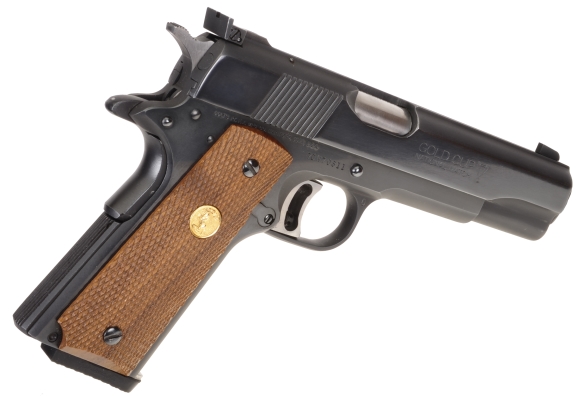
Both my wife and I, and each of our three sons,spent the most time developed handgun marksmanship skills with this Gold Cup. Our children were 8, 9 and 10 years of age. My wife remains the 1911 ace in the household with exceptional hand/eye coordination and incredible ability to focus.
|
Colt MK IV / Series’ 70 Gold Cup National Match |
|
| Manufacturer | Colt |
| Point of Origin | West Hartford, CT |
| Type | 1911 Auto Loader |
| Caliber | 45 Auto |
| Magazine Capacity | 7 |
| Barrel Length “ | 5.0″ |
| Rifling | 1:16″ 6 Grooves |
| Overall Length” * | 8 3/8″ |
| Overall Height ” * | 5.25″ |
| Weight Oz. * | 36 Oz. |
| Sight Radius * | 6 3/4″ |
| Trigger Pull * | 2 Lbs 10 Oz. |
| Rear Sight | Ellison adjustable |
| Front Sight | Staked Post |
| Barrel Material | Carbon Steel – Match |
| Slide/Frame | Blued Carbon Steel |
| Safety | Grip and Thumb |
John Browning’s Model 1911 was designed to fit the average male of that time. Subsequently, the grip is sized to a modern medium to large male hand and all of the controls are within the anticipated thumb/finger reach and, with a little effort and practice, suits women and young shooters as well.
The Colt has seen essentially two types of ammo. The first, Remington or Federal 185 grain SWC target ammo @ 770 fps when available, or a handloaded equivalent of the same. The second, a variety of brands of standard velocity, 875 fps, 230 grain JHP loads. Pictured, Remington HD Ultimate Defense. The pistol is configured with a 14 lb spring with the former and 16 lb spring with the latter.
What is not here…
Not so much different that the way JMB designed the 1911. No ramped barrel, no full length guide rod, no tightened rails, no precision fit barrel bushing. No, the collet bushing has not failed, but then the pistol has been well maintained and the bushing has remained lubricated and on the barrel with few exceptions. The National Match cycles 100% reliably; no dented brass, no stove pipes, no failures to feed, no misfires.
Sights
The 45 caliber 1911 is a very narrow pistol, approximately 1″ across the grips and 0.900″ across the slide. The Ellison rear sight popped off constantly during the first month of use. Colt remedied the problem by using a slightly oversize mount pin and there has been no further problem. While the sights are mechanically well suited to target shooting, the presentation, black on black, is not. Most of my other pistols have fiber optic sights or at least white outlined rear sight apertures and white face post front sights.
Finish
No wonder finishes; plasma, nitride or epoxy. just black oxide. I think finish remains about 99% with two minuscule ticks. The first at the rear sight pin where a factory tech had an unsteady hand holding a punch. The second, on the frame where someone was careless reinstalling the slide stop. Probably not noticeable by most, but when you own a firearm you tend to know where all of these are.
 The plain checkered walnut grips provide plenty of traction, the slide stop, thumb safety and magazine release are perfect when operated as intended. My ’90 Officer’s Model has been extensively modified and reworked with controls extended, trigger lightened, tool steel fire control pieces and hammer, etc. In short, it looks like it fell victim to disco. Fortunately, I have all of the original pieces and a replacement factory slide, so the gun is on its way back to restoration. Will not look or function as good as the Gold Cup, but it will be better than it is now.
The plain checkered walnut grips provide plenty of traction, the slide stop, thumb safety and magazine release are perfect when operated as intended. My ’90 Officer’s Model has been extensively modified and reworked with controls extended, trigger lightened, tool steel fire control pieces and hammer, etc. In short, it looks like it fell victim to disco. Fortunately, I have all of the original pieces and a replacement factory slide, so the gun is on its way back to restoration. Will not look or function as good as the Gold Cup, but it will be better than it is now.
Not CNC machined….
I’ve often seen the comment in social media that the new guns are better because parts are made on CNC machinery. Not really. First of all, many critical parts are metal injection molded, superficially hardened and sometimes quite ugly to look at through a magnifying lens. Additionally, computer control is never better than the quality of machinery it is controlling and the person who did the set upprogramming. What CNC does well is make a lot of identical parts, which may be close or wide on tolerance, in or out of spec.
Tolerance stacking in a 1911 assembly can be significant as there are so many clearances determined by frame hole location and then within a subassembly. A person sitting at a bench selecting piece parts by fit or operating a machine to precision tolerances, can produce an optimal result. Run a fit check on a factory 1911 from a mass producer and you will find most need extensive clean up, machine work, before they can really shoot well.
Recoil and muzzle rise
A standard pressure 45 Automatic cartridge, fired from a full length steel 1911 pistol, generates only moderate recoil and muzzle rise. 45 Super version have a bit more and the 460 Rowland more still. None are as… awakening as a 44 Magnum revolver or 10 mm Automatic. Which means all are useful for the average person. Loaded with 770 fps SWC bullets, recoil is modest.
Power
There was a time in not too distant history, when the 45 Automatic 1911 was considered a heavy stopper. As a self defense firearm, in the real world that would still be the case. In the Internet world of social media where the average criminal wears body armor and attacks as part of a group of 20, perhaps not.
According to Jerry Kuhnhausen’s 1911 shop manual, M1911 Match Ball Ammo has a muzzle velocity of 830 fps. Maximum range with pistol held up at a 30° angle is 1640 yards. Penetration in white pine @ 25 yards is 6″, penetration at 250 yards is 4″. According to military criteria, both constitute a mortal wound depth. The two firearms I trust the most to self defense duty is a 357 Magnum revolver and a 1911 pistol in 45 Automatic.
Accuracy… the hand holding the grip.
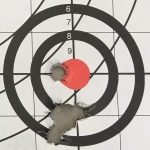
Shooting with hands supported on a rest, the bullseye was first… which made me feel cocky… which lead to the next group of five going 3/4″ lower. If I count all 6 rounds, the group is 1 1/2″. If I take the lower five, the group is 3/4″. The ammo was 185 grain SWC target handloads. Were all groups this small? No, of course not. But I do believe this group reflects the pistol’s mechanical accuracy potential, which I can only occasionally exercise.
My point? Bet you didn’t think I had one…
Many people talk about these old, out of production guns as though they no longer exist. Far from the truth. If there is a firearm of this type that you like, track it down. Not perfect? Restore it, or leave it as it is if performance is as it should be. If you all ready own one, don’t be so quick to get rid of it so you can purchase a new firearm that won’t have the core quality or the character.

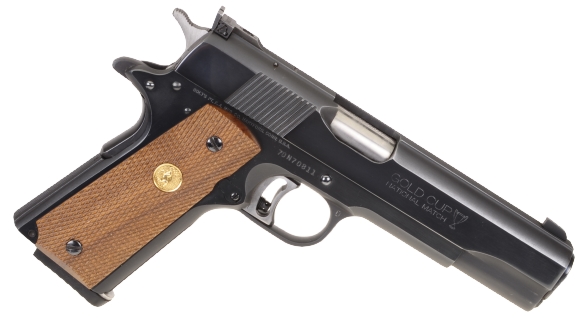

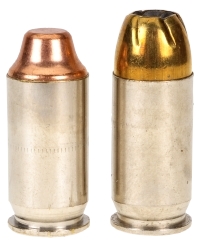


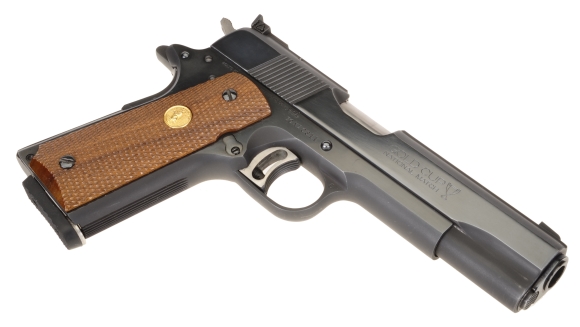
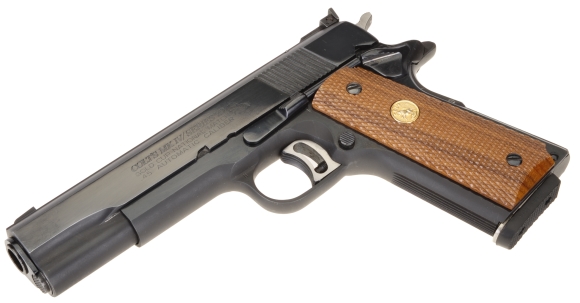
Email Notification